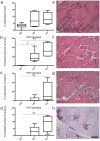Allele copy number and underlying pathology are associated with subclinical severity in equine type 1 polysaccharide storage myopathy (PSSM1)
- PMID: 22860112
- PMCID: PMC3409190
- DOI: 10.1371/journal.pone.0042317
Allele copy number and underlying pathology are associated with subclinical severity in equine type 1 polysaccharide storage myopathy (PSSM1)
Abstract
Equine type 1 polysaccharide storage myopathy (PSSM1), a common glycogenosis associated with an R309H founder mutation in the glycogen synthase 1 gene (GYS1), shares pathological features with several human myopathies. In common with related human disorders, the pathogenesis remains unclear in particular, the marked phenotypic variability between affected animals. Given that affected animals accumulate glycogen and alpha-crystalline polysaccharide within their muscles, it is possible that physical disruption associated with the presence of this material could exacerbate the phenotype. The aim of this study was to compare the histopathological changes in horses with PSSM1, and specifically, to investigate the hypothesis that the severity of underlying pathology, (e.g. vacuolation and inclusion formation) would (1) be higher in homozygotes than heterozygotes and (2) correlate with clinical severity. Resting and post-exercise plasma creatine kinase (CK) and aspartate aminotransferase (AST) enzyme activity measurements and muscle pathology were assessed in matched cohorts of PSSM1 homozygotes, heterozygotes or control horses. Median (interquartile range (IR)) resting CK activities were 364 (332-764) U/L for homozygotes, 301 (222-377) U/L for heterozygotes and 260 (216-320) U/L for controls, and mean (+/- SD) AST activity for homozygotes were 502 (+/116) U/L, for heterozygotes, 357 (+/-92) U/L and for controls, 311 (+/-64) U/L and were significantly different between groups (P = 0.04 and P = 0.01 respectively). Resting plasma AST activity was significantly associated with the severity of subsarcolemmal vacuolation (rho = 0.816; P = 0.01) and cytoplasmic inclusions (rho = 0.766; P = 0.01). There were fewer type 2× and more type 2a muscle fibres in PSSM1-affected horses. Our results indicate that PSSM1 has incomplete dominance. Furthermore, the association between plasma muscle enzyme activity and severity of underlying pathology suggests that physical disruption of myofibres may contribute to the myopathic phenotype. This work provides insight into PSSM1 pathogenesis and has implications for related human glycogenoses.
Conflict of interest statement
Figures






Similar articles
-
Evaluation of cardiac phenotype in horses with type 1 polysaccharide storage myopathy.J Vet Intern Med. 2012 Nov-Dec;26(6):1464-9. doi: 10.1111/j.1939-1676.2012.00988.x. Epub 2012 Sep 15. J Vet Intern Med. 2012. PMID: 22978303
-
Type 2 polysaccharide storage myopathy in Quarter Horses is a novel glycogen storage disease causing exertional rhabdomyolysis.Equine Vet J. 2023 Jul;55(4):618-631. doi: 10.1111/evj.13876. Epub 2022 Sep 14. Equine Vet J. 2023. PMID: 36102343
-
Clinical characteristics and muscle glycogen concentrations in warmblood horses with polysaccharide storage myopathy.Am J Vet Res. 2017 Nov;78(11):1305-1312. doi: 10.2460/ajvr.78.11.1305. Am J Vet Res. 2017. PMID: 29076373
-
Polysaccharide Storage Myopathy.Vet Clin North Am Equine Pract. 2025 Apr;41(1):125-137. doi: 10.1016/j.cveq.2024.11.004. Epub 2025 Jan 31. Vet Clin North Am Equine Pract. 2025. PMID: 39893126 Review.
-
Muscle Conditions Affecting Sport Horses.Vet Clin North Am Equine Pract. 2018 Aug;34(2):253-276. doi: 10.1016/j.cveq.2018.04.004. Epub 2018 May 28. Vet Clin North Am Equine Pract. 2018. PMID: 29853158 Review.
Cited by
-
A highly prevalent equine glycogen storage disease is explained by constitutive activation of a mutant glycogen synthase.Biochim Biophys Acta Gen Subj. 2017 Jan;1861(1 Pt A):3388-3398. doi: 10.1016/j.bbagen.2016.08.021. Epub 2016 Aug 31. Biochim Biophys Acta Gen Subj. 2017. PMID: 27592162 Free PMC article.
-
251st ENMC international workshop: Polyglucosan storage myopathies 13-15 December 2019, Hoofddorp, the Netherlands.Neuromuscul Disord. 2021 May;31(5):466-477. doi: 10.1016/j.nmd.2021.01.010. Epub 2021 Jan 23. Neuromuscul Disord. 2021. PMID: 33602551 Free PMC article. No abstract available.
References
-
- Vucic S, Pamphlett R, Wills EJ, Yiannikas C (2007) Polyglucosan body disease myopathy: an unusual presentation. Muscle & nerve 35: 536–539. - PubMed
-
- Brojer JT, Essen-Gustavsson B, Annandale EJ, Valberg SJ (2006) Proglycogen, macroglycogen, glucose, and glucose-6-phosphate concentrations in skeletal muscles of horses with polysaccharide storage myopathy performing light exercise. American journal of veterinary research 67: 1589–1594. - PubMed
-
- Argov Z, Bank WJ, Maris J, Leigh JS Jr, Chance B (1987) Muscle energy metabolism in human phosphofructokinase deficiency as recorded by 31P nuclear magnetic resonance spectroscopy. Annals of neurology 22: 46–51. - PubMed
MeSH terms
Substances
LinkOut - more resources
Full Text Sources
Other Literature Sources
Medical
Research Materials

